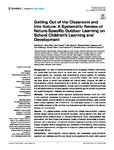Getting Out of the Classroom and Into Nature: A Systematic Review of Nature-Specific Outdoor Learning on School Children's Learning and Development
| dc.contributor.author | Mann, J | |
| dc.contributor.author | Gray, T | |
| dc.contributor.author | Truong, S | |
| dc.contributor.author | Brymer, E | |
| dc.contributor.author | Passy, R | |
| dc.contributor.author | Ho, S | |
| dc.contributor.author | Sahlberg, P | |
| dc.contributor.author | Ward, K | |
| dc.contributor.author | Bentsen, P | |
| dc.contributor.author | Curry, C | |
| dc.contributor.author | Cowper, R | |
| dc.date.accessioned | 2022-06-20T12:39:29Z | |
| dc.date.issued | 2022-05-16 | |
| dc.identifier.issn | 2296-2565 | |
| dc.identifier.issn | 2296-2565 | |
| dc.identifier.other | 877058 | |
| dc.identifier.uri | http://hdl.handle.net/10026.1/19319 | |
| dc.description.abstract |
<jats:sec><jats:title>Background:</jats:title><jats:p>The value of natural environments for developing children's self-identity and social skills has been known for some time, and more recently the potential of nature-specific (i.e., excluding built environments) outdoor learning for achieving academic outcomes has been explored. Connecting children with natural spaces has been shown to benefit their physical and mental health; however, the utility of nature-specific outdoor environments as a setting for curricular and non-curricular learning has yet to be clearly established. Our aim was to undertake a narrative synthesis of international evidence of nature-specific outdoor learning and its benefits for personal and social development, wellbeing and academic progress.</jats:p></jats:sec><jats:sec><jats:title>Methods</jats:title><jats:p>This systematic review searched publications between 2000 and 2020 in nine academic databases for evidence of socio-emotional and academic benefits of nature-specific outdoor learning in school-aged educational settings, using concise search criteria registered with PROSPERO. The total search results of 17,886 records were initially screened by title, and then two reviewers made blind reviews of the title and abstract of 1,019 records.</jats:p></jats:sec><jats:sec><jats:title>Results</jats:title><jats:p>147 original research studies meeting the criteria were identified. Learning settings ranged across outdoor adventure education, school gardens, field trips, and traditional school subjects taught in natural environments. Study characteristics were summarized, and risk-of-bias tools assessed quality of research as generally moderate, although with a wide range. The reported benefits of learning in natural outdoor settings include: increased student engagement and ownership of their learning, some evidence of academic improvement, development of social and collaborative skills, and improved self-concept factors.</jats:p></jats:sec><jats:sec><jats:title>Conclusions</jats:title><jats:p>Nature-specific outdoor learning has measurable socio-emotional, academic and wellbeing benefits, and should be incorporated into every child's school experience with reference to their local context. Teacher pre-service and in-service education needs to include a focus on how natural settings can be used effectively for learning. Further research is needed to clarify the conditions under which specific forms of outdoor learning are most efficacious for various target outcomes. It is recommended that future studies measuring outdoor learning adopt established methodologies to improve the quality of research in this field.</jats:p></jats:sec><jats:sec><jats:title>Systematic Review Registration</jats:title><jats:p><jats:ext-link>https://www.crd.york.ac.uk/prospero/display_record.php?RecordID=153171</jats:ext-link>.</jats:p></jats:sec> | |
| dc.format.extent | 877058- | |
| dc.format.medium | Electronic-eCollection | |
| dc.language | eng | |
| dc.language.iso | eng | |
| dc.publisher | Frontiers Media | |
| dc.subject | academic improvement | |
| dc.subject | education | |
| dc.subject | learning outside the classroom | |
| dc.subject | nature-specific | |
| dc.subject | outdoor learning | |
| dc.subject | pro-environmental behavior | |
| dc.subject | socio-emotional | |
| dc.subject | wellbeing | |
| dc.title | Getting Out of the Classroom and Into Nature: A Systematic Review of Nature-Specific Outdoor Learning on School Children's Learning and Development | |
| dc.type | journal-article | |
| dc.type | Review | |
| plymouth.author-url | https://www.ncbi.nlm.nih.gov/pubmed/35651851 | |
| plymouth.volume | 10 | |
| plymouth.publication-status | Published online | |
| plymouth.journal | Frontiers in Public Health | |
| dc.identifier.doi | 10.3389/fpubh.2022.877058 | |
| plymouth.organisational-group | /Plymouth | |
| plymouth.organisational-group | /Plymouth/Research Groups | |
| plymouth.organisational-group | /Plymouth/Research Groups/Institute of Health and Community | |
| plymouth.organisational-group | /Plymouth/Users by role | |
| plymouth.organisational-group | /Plymouth/Users by role/Academics | |
| dc.publisher.place | Switzerland | |
| dcterms.dateAccepted | 2022-04-19 | |
| dc.rights.embargodate | 2022-6-21 | |
| dc.identifier.eissn | 2296-2565 | |
| dc.rights.embargoperiod | Not known | |
| rioxxterms.versionofrecord | 10.3389/fpubh.2022.877058 | |
| rioxxterms.licenseref.uri | http://www.rioxx.net/licenses/all-rights-reserved | |
| rioxxterms.licenseref.startdate | 2022 | |
| rioxxterms.type | Journal Article/Review |


